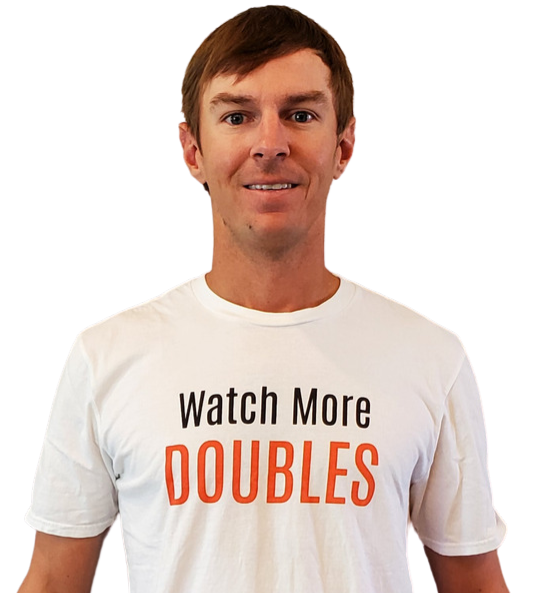Below you’re going to learn from some of the the best doubles players & coaches in the world.
I’ve asked professional doubles players, including major champions, and top coaches in the world of tennis one simple question.
What is the Biggest Mistake Doubles Players Make?
Here are their answers…
Rajeev Ram

Olympic Silver Medalist. Australian Open Men’s & Mixed Doubles Champion. US Open Champion.
Rajeev’s Answer: I see players not communicating with or energizing their partner. Doubles, after all, is it team game and the better you can make your partner play the more it will benefit you. I would say that is one area that is really neglected in doubles.
Related Content
Listen to our Rajeev Ram Interview on the Doubles Only Tennis Podcast
Nicole Melichar

Wimbledon Mixed Doubles Champion, WTA Top 10, USA FedCup Member & Olympian.
Nicole’s Answer: The most common mistake is that players don’t communicate with their partners enough! Different levels have different abilities, but both players should have an idea of which shot is theirs to hit and which is their partners. Having good communication involves saying “yours” or “mine”, or also telling your partner before the point where you might try to hit the ball to start off the point! If
Related Content
Listen to our Nicole Melichar Interview on the Doubles Only Tennis Podcast
Kaitlyn Christian

USC graduate. NCAA Doubles Champion and currently ranked #38 WTA in doubles. Body double for Emma Stone in Battle of the Sexes.
Kaitlyn’s Answer: The most common mistake I see people make in doubles is not being aggressive enough. Some people are afraid to get “hit” by the ball and don’t make moves to cut balls off or poach. The biggest key to doubles is movement. Making areas seem smaller for your opponents to hit into and baiting them to play the ball to where you want it. Don’t be afraid to get passed down the line because

25 Winning Doubles Tactics Guaranteed to Help You Play Smarter
Ebook with 25 expert serve (7), return (5), net-play (5), baseline (4), & approach (4) tactics you can use in your next doubles match.
Craig O’Shannessy

Strategy analyst for ATP Tour, Wimbledon, Australian Open, formerly Team Djokovic, Matteo Berrettini, and the Italian Tennis Federation. Founder of Brain Game Tennis.
Craig’s Answer: Covering the line too much. A doubles court is shaped like an hourglass, with two big ends (the baseline) and a small neck in the middle of the court (The Center Window) where the ball continuously flows. Players get embarrassed about getting beat down the line. Give it up and crush the middle of the court, where almost all of the action is.
Related Content
Listen to our Craig O’Shannessy Interview on the Doubles Only Tennis Podcast
Ian Westermann

Founder of Essential Tennis.
Ian’s Answer: The most common mistake I see doubles players make is what I like to call “resetting the point”. They work hard to make their opponents uncomfortable, push them off balance, and cough up a weak, easy shot across the middle of the court. The net player makes their move, expertly intercepts the ball well above the height of the net, and then hits it aggressively towards the opponent who is best equipped to handle it: the baseline player! What comes next? A lob, of course, which is the most complained about
If you want to avoid that frustration then picking the right targets to fit each point scenario is critical. Most offensive opportunities should be targeted towards the opponent closest to the net because they have the least amount of time to react and their feet are usually the most available to hit towards. Most defensive or neutral situations should target the opponent who’s FURTHEST from the net because that player is typically least set up to finish the point in their favor. Plus, hitting to the player further away from you will give you and your partner the most amount of time to get into position for the next shot
Related Content
Listen to our Ian Westermann Interview on the Doubles Only Tennis Podcast
Jack Broudy

Tennis Coach, Speaker, Author, and Inventor. Jack has influenced the development of several pros on tour today, as well as countless top ranked USTA Juniors and college national champion players and coaches. Founder of Broudy Tennis.
Jack’s Answer: When I watch doubles at the amateur or club level I find the biggest mistake is that the lack of split-level. The split-step is the hop a player makes as the ball is being struck by the opponent. This move is key because it gets you in an athletic posture (knees slightly bent and lower) and pushes you up into the first step, and in doubles, where the serve return and net play are so dominant, the first step is crucial. Players on
Related Content
Listen to our Jack Broudy Interview on the Doubles Only Tennis Podcast
Steve Smith

Steve has 45 years of diversified teaching and coaching experience. His career can be measured by the results of his students as players and the results of his students as tennis leaders. Steve designed and developed the first comprehensive curriculum and degree plan for tennis teachers and has a network of coaches around the world who teach beginners to get a great base. Founder of
Steve’s Answer: The most common mistake in doubles is playing one-up-one-back. One-up-one-back only works if the other players play one-up-one-back. Sure, there are exceptions. Often the players with superior athletic ability and inferior tactics beat the players with inferior athletic ability and superior tactics.
I tease and tell people that they need two things to be a serve-and-volley player; a
The solution to the problem is to simply go forward. Governing tennis bodies around the world have agreed on new rules for young players to play with transition balls and shorter courts. A new rule should be added called – One-Bounce-Doubles. The serving team loses the point if the ball bounces on their side and the returning team loses if the ball bounces more than once on their side. If I had a vote, the rule would be in place through the 14-and- under age group. As a result, the art of playing serve-and-volley doubles would be saved.
Related Content
Listen to our Steve Smith Interview on the Doubles Only Tennis Podcast
Will Boucek

Founder of The Tennis Tribe. ATP & WTA Doubles Strategy Analyst. Worked with teams at all 4 Grand Slams, Indian Wells, and the WTA Finals.
My Answer: I see too many players move forward and back at the net, but not laterally. This makes it very easy for your opponent to get into a rhythm hitting (especially returning) crosscourt.
Doubles players get embarrassed when they get beat down the line or miss a volley at the net, but it’s only 1 point. They typically neglect to count all the times the opponent tried to hit the doubles alley and missed. As a result, they don’t move side to side and they cover too much of the alley, giving the opponent a huge area to hit into crosscourt.
The alley is not where doubles matches are won. I’ve never heard someone say “we took over the doubles alleys and won that match.” It doesn’t happen. Move laterally more and give up some of the
Free Weekly Doubles Lessons
Join the #1 Doubles Strategy Newsletter and get my Net Play Guide: 3 Doubles Tactics to Force Errors & Get More Easy Volleys for free!
– Will Boucek, ATP & WTA doubles strategy analyst

“I found your site a couple weeks ago and used your guide for net play. It worked well! Playing again this morning so we will see how it goes!”
– Julie, Club Doubles Player
Takeaways From These Doubles Experts
After reading these answers, there are a few topics that seem to come up several times. Here’s what I noticed.
- Communication with your partner is VERY important & under appreciated.
Before the point, know where your partner is hitting, and who should cover what. This seems obvious but make it a focus, especially when playing with new doubles partners. - Making your opponent uncomfortable is key to winning doubles.
Whether it’s making them hit the more difficult shot down the alley or hitting at the other net player, you need to make the other team uncomfortable first. - The biggest mistakes and opportunities to improve are at the net!
Almost everyone mentioned playing at the net. Serve and volley, split -step before you get to the net, be aggressive once you get there, hit at the other net player… Net play is still the most important part of good doubles strategy.
Related Content
Listen to our Jorege Capestany Interview on the Podcast & learn how to be a better doubles partner and improve team chemistry.
Have something to add?
If your a doubles coach or player, comment below with your answer! What is the biggest mistake doubles player make?
You could be included in the next doubles roundup article 😉

All good comments. mine is not have a ‘dictate play’ short, sharp, mindset.
The VASTS majority of points last six shots or less. IE between 0.25 and 3.0 seconds…with 25 seconds between the points.
Should play like an ALIVE ECG rather than a flatlining, one pace, endurance ‘DEAD’ ECG!!
Great points Mark!
You have 25 seconds to get your mind right, so you can focus & go 100% effort for only a few seconds. Focus is so important and having the mindset to hit your targets on the first several shots will help you win more matches for sure.
This is related to communicating with your partner too. If I’m serving down the T, you need to know so that you can pinch. And I need to know that you’re pinching so I can cover the other areas of the court.
Thanks for the comments
Bravo and bang on the button. How to sure this is the big question